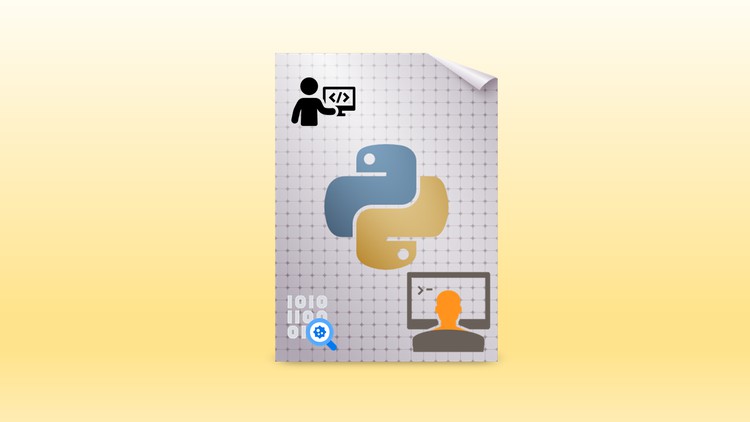Learn programming from scratch with Python
- Description
- Curriculum
- FAQ
- Reviews
Whether you are an experienced programmer or not, this course is intended for everyone who wishes to learn the Python programming language.
This course outlines the process from learning the basis of programming with Python and start writing your own code.
Python is a powerful general-purpose programming language
It is used in web development, data science, creating software prototypes, and so on.
It is so powerful and easy that it is recommended to whom wants to start learning software programming even with no experience and knowledge.
In this course students will learn:
- How to install and run Python on your computer and write your first Python program
- keywords (reserved words in Python) and identifiers (names given to variables, functions, etc.)
- Python statements, why indentation is important and use of comments in programming
- Python variables, constants, literals and their use cases
- Type conversion and uses of type conversion
- Python Operators
- Python Namespaces
- print() and input() to perform I/O tasks in Python
- Python Data Types (Python Numbers, Python List, Python Tuple, Python String, Python Set, Python Dictionary)
- Flow Control (IF Statements, Loops – For, While,…)
- Functions (Function Argument, Python Recursion, Anonymous Function, Global, Local and Nonlocal, Python Global Keyword, Python Modules,Python Package)
- Manage Files (Python File Operation, Python Directory, Python Exception, Exception Handling, User-defined Exception)
- Python Object Oriented Programming (OOP) (Python OOP, Python Objects & Classes, Python Inheritance, Multiple Inheritance, Encapsulation, Polymorphism, Operator Overloading)
- Advanced Functionalities (Python Iterator, Python Generator, Python Closure, Python Decorators, Python Property, Python RegEx, Serialization, Special Functions)
- Data Science Applications (Numpy, Pandas)
Everything enriched by exercises, applications and special bonuses to learn how to write optimized software code
-
1IntroductionVideo lesson
-
2Why You Want To Learn Programming?Video lesson
-
3Pick a Programming Language To LearnVideo lesson
-
4Why should you pick up and learn PythonVideo lesson
-
5Learn In Small ChunksVideo lesson
-
6Start At The BeginningVideo lesson
-
7Learn and TeachVideo lesson
-
8Do not give upVideo lesson
-
9Should I learn programming if I don’t want to be a programmer?Video lesson
-
15Python KeywordsVideo lesson
keywords (reserved words in Python) and identifiers (names given to variables, functions, etc.)
-
16Statements & CommentsVideo lesson
Python statements, why indentation is important and use of comments in programming
-
17DocstringsVideo lesson
A docstring is short for documentation string.
Python docstrings (documentation strings) are the string literals that appear right after the definition of a function, method, class, or module
-
18Python Variables & ConstantsVideo lesson
In this lecture, you will learn about Python variables, constants, and their use cases
A variable is a named location used to store data in the memory. It is helpful to think of variables as a container that holds data that can be changed later in the program.
A constant is a type of variable whose value cannot be changed. It is helpful to think of constants as containers that hold information which cannot be changed later
-
19Python LiteralsVideo lesson
Literal is a raw data given in a variable or constant. In Python, there are various types of literals:
Numeric Literals are immutable (unchangeable). Numeric literals can belong to 3 different numerical types: Integer, Float, and Complex.
A string literal is a sequence of characters surrounded by quotes. We can use both single, double, or triple quotes for a string.
A Boolean literal can have any of the two values: True or False.
Python contains one special literal i.e. None. We use it to specify that the field has not been created.
There are four different literal collections List literals, Tuple literals, Dict literals, and Set literals.
-
20Python DatatypesVideo lesson
In this lecture, you will learn about different data types you can use in Python.
Every value in Python has a datatype. Since everything is an object in Python programming, data types are actually classes and variables are instance (object) of these classes
-
21Python Type Conversion (I)Video lesson
In this lecture, you will learn about the Type conversions and uses of type conversions.
The process of converting the value of one data type (integer, string, float, etc.) to another data type is called type conversion. Python has two types of type conversion.
Implicit Type Conversion
Explicit Type Conversion
In Implicit type conversion, Python automatically converts one data type to another data type. This process doesn't need any user involvement.
In Explicit Type Conversion, users convert the data type of an object to required data type. We use the predefined functions like int(), float(), str(), etc to perform explicit type conversion
-
22Python Type Conversion (II)Video lesson
-
23Python I/O: printVideo lesson
This lecture focuses on two built-in functions print() and input() to perform I/O tasks in Python.
You will also learn to import modules and use them in your program.
-
24Python I/O: inputVideo lesson
-
25Python ImportVideo lesson
-
26Python OperatorsVideo lesson
In this lecture, you'll learn everything about different types of operators in Python, their syntax and how to use them with examples.
Operators are special symbols in Python that carry out arithmetic or logical computation. The value that the operator operates on is called the operand
-
27Python Namespace (I)Video lesson
In this lecture, you will learn about namespaces, mapping from names to objects, and scope of a variable.
Name (also called identifier) is simply a name given to objects. Everything in Python is an object. Name is a way to access the underlying object.
A namespace is a collection of names.
-
28Python Namespace (II)Video lesson
-
29Python Namespace (III)Video lesson
-
30Python Namespace (IV)Video lesson
-
31Python if...else (I)Video lesson
In this lecture, you will learn to create decisions in a Python program using different forms of if..else statement
-
32Python if...else (Ii)Video lesson
-
33Python if...else (III)Video lesson
-
34Python if...else (IV)Video lesson
-
35Python for LoopVideo lesson
In this lecture, you'll learn to iterate over a sequence of elements using the different variations of for loop
-
36Python while LoopVideo lesson
Loops are used in programming to repeat a specific block of code. In this lecture, you will learn to create a while loop in Python
-
37Python break and continueVideo lesson
In this lecture, you will learn to use break and continue statements to alter the flow of a loop
-
38Python PassVideo lesson
In this lecture, you'll learn about pass statement. It is used as a placeholder for future implementation of functions, loops, etc.
-
39Python FunctionsVideo lesson
In this lecture, you'll learn about functions, what a function is, the syntax, components, and types of functions. Also, you'll learn to create a function in Python
-
40Function ArgumentVideo lesson
-
41Python RecursionVideo lesson
-
42Anonymous FunctionVideo lesson
In Python, an anonymous function is a function that is defined without a name.
While normal functions are defined using the def keyword in Python, anonymous functions are defined using the lambda keyword.
-
43Python Global, Local and Nonlocal variablesVideo lesson
In this lecture, you’ll learn about Python Global variables, Local variables, Nonlocal variables and where to use them.
-
44Python Global KeywordVideo lesson
In this lecture, you’ll learn about the global keyword, global variable and when to use global keywords.
-
45Python ModulesVideo lesson
In this lecture, you will learn to create and import custom modules in Python. Also, you will find different techniques to import and use custom and built-in modules in Python.
Modules refer to a file containing Python statements and definitions.
-
46Python PackageVideo lesson
In this lecture, you'll learn to divide your code base into clean, efficient modules using Python packages. Also, you'll learn to import and use your own or third party packages in your Python program.
-
47Python NumbersVideo lesson
In this lecture, you'll learn about the different numbers used in Python, how to convert from one data type to the other, and the mathematical operations supported in Python.
Python supports integers, floating-point numbers and complex numbers. They are defined as int, float, and complex classes in Python.
-
48Python List (I)Video lesson
In this and next lectures, you'll learn everything about Python lists, how they are created, slicing of a list, adding or removing elements from them and so on.
Python offers a range of compound data types often referred to as sequences. List is one of the most frequently used and very versatile data types used in Python.
-
49Python List (II)Video lesson
-
50Python Tuple (I)Video lesson
In this and next lectures, you'll learn everything about Python tuples. More specifically, what are tuples, how to create them, when to use them and various methods you should be familiar with.
A tuple in Python is similar to a list. The difference between the two is that we cannot change the elements of a tuple once it is assigned whereas we can change the elements of a list.
-
51Python Tuple (II)Video lesson
-
52Python String (I)Video lesson
In this and next lectures you will learn to create, format, modify and delete strings (a string is a sequence of characters) in Python. Also, you will be introduced to various string operations and functions.
-
53Python String (II)Video lesson
-
54Python String (III)Video lesson
-
55Python String (IV)Video lesson
-
56Python Set (I)Video lesson
In this and next lecture, you'll learn everything about Python sets; how they are created, adding or removing elements from them, and all operations performed on sets in Python.
A set is an unordered collection of items. Every set element is unique (no duplicates) and must be immutable (cannot be changed).
-
57Python Set (II)Video lesson
-
58Python DictionaryVideo lesson
In this lecture, you'll learn everything about Python dictionaries; how they are created, accessing, adding, removing elements from them and various built-in methods.
Python dictionary is an unordered collection of items. Each item of a dictionary has a key/value pair.
-
59Python File Operation (I)Video lesson
In this and next lecture, you'll learn about Python file operations. More specifically, opening a file, reading from it, writing into it, closing it, and various file methods that you should be aware of.
-
60Python File Operation (II)Video lesson
-
61Python DirectoryVideo lesson
In this lecture, you'll learn about file and directory management in Python, i.e. creating a directory, renaming it, listing all directories, and working with them.
-
62Python ExceptionVideo lesson
In this lecture, you will learn about different types of errors and exceptions that are built-in to Python. They are raised whenever the Python interpreter encounters errors.
We can make certain mistakes while writing a program that lead to errors when we try to run it. A python program terminates as soon as it encounters an unhandled error. These errors can be broadly classified into two classes:
Syntax errors
Logical errors (Exceptions)
-
63Python Exception Handling (I)Video lesson
In this and next lectures, you'll learn how to handle exceptions in your Python program using try, except and finally statements with the help of examples.
-
64Python Exception Handling (II)Video lesson
-
65Python Exception Handling (III)Video lesson
-
66Python Exception Handling (IV)Video lesson
-
67Python User-defined ExceptionVideo lesson
In this lecture, you will learn how to define custom exceptions depending upon your requirements with the help of examples.
Python has numerous built-in exceptions that force your program to output an error when something in the program goes wrong.
However, sometimes you may need to create your own custom exceptions that serve your purpose.
-
68Python OOPVideo lesson
In this lecture, you’ll learn about Object-Oriented Programming (OOP) in Python and its fundamental concept with the help of examples.
Python is a multi-paradigm programming language. It supports different programming approaches.
One of the popular approaches to solve a programming problem is by creating objects. This is known as Object-Oriented Programming (OOP).
An object has two characteristics:
attributes
behavior
-
69Python OOP: Classes and Objects (I)Video lesson
In this and next lecture, you will learn about the core functionality of Python objects and classes. You'll learn what a class is, how to create it and use it in your program.
Python is an object oriented programming language. Unlike procedure oriented programming, where the main emphasis is on functions, object oriented programming stresses on objects.
An object is simply a collection of data (variables) and methods (functions) that act on those data. Similarly, a class is a blueprint for that object.
-
70Python OOP: Classes and Objects (II)Video lesson
-
71Python OPP: Classes: definitionVideo lesson
-
72Python OPP: Classes: initialization (I)Video lesson
-
73Python OPP: Classes: initialization (II)Video lesson
-
74Python OOP: inheritance (I)Video lesson
Inheritance enables us to define a class that takes all the functionality from a parent class and allows us to add more. In this tutorial, you will learn to use inheritance in Python.
Inheritance is a powerful feature in object oriented programming.
It refers to defining a new class with little or no modification to an existing class. The new class is called derived (or child) class and the one from which it inherits is called the base (or parent) class.
-
75Python OOP: inheritance (II)Video lesson
-
76Pythin OOP: Multiple InheritanceVideo lesson
In this lecture, you'll learn about multiple inheritance in Python and how to use it in your program. You'll also learn about multi-level inheritance and the method resolution order.
A class can be derived from more than one base class in Python. This is called multiple inheritance.
In multiple inheritance, the features of all the base classes are inherited into the derived class.
-
77Python OOP: encapsulationVideo lesson
Using OOP in Python, we can restrict access to methods and variables. This prevents data from direct modification which is called encapsulation.
-
78Python OOP: polymorphismVideo lesson
Polymorphism is an ability (in OOP) to use a common interface for multiple forms (data types).
-
79Operator Overloading (I)Video lesson
You can change the meaning of an operator in Python depending upon the operands used. In this and net lectures, you will learn how to use operator overloading in Python Object Oriented Programming.
-
80Operator Overloading (II)Video lesson
-
81Operator Overloading (III)Video lesson

External Links May Contain Affiliate Links read more





